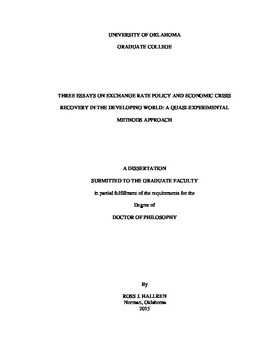| dc.description.abstract | My research explores the effect of monetary systems on how quickly developing countries recover from economic crises. Existing research typically assumes that countries that do not take on a given policy are an appropriate counterfactual for countries that do. Often, these two groups of countries are not comparable, and tests of this assumption in my research indicate these two groups are, on average, different across determinants of the outcomes of interest. Therefore, many established results are likely biased. I address these issues of non-random selection of macroeconomic policies using quasi-experimental methods, such as propensity score matching, coarsened exact matching, and synthetic counterfactuals, to estimate treatment effects. These econometric methods allow me to identify control and treatment group countries that are observationally similar across relevant factors, and therefore unbiasedly estimate the average treatment effect on the treated.
In my first chapter, I use the synthetic control method (SCM) to estimate the impact of official dollarization in Ecuador and quasi-dollarization, in the form of a currency board, in Argentina. The SCM is a relatively new econometric technique, developed by Abadie and Gardeazabal (2003), and it is uniquely suited for evaluating a monetary policy, such as dollarization, where the potential treated sample is so small as to make traditional econometric techniques ineffective. I show that these monetary arrangements were effective at controlling inflation in both countries. Interestingly, in contrast with previous research, I find these policies had no impact on real income. Despite the success of these policies, Argentina abandoned its currency board in 2002, devalued its currency, and repudiated much of its outstanding government debt causing renewed inflation and a loss of significant consumer wealth. Ecuador, conversely, continues to operate under dollarization, fourteen years after implementation.
This line of research is important for policymakers who are considering joining a currency union, such as the European Union (EU) or the de-factor U.S. dollar or Sterling unions. In particular, my research confirms one must give careful consideration to government spending balance and the timing of one’s business cycle with that of the other members of the union. One example is Scotland, which in September had referendum for independence and if passed, would have formed a de-facto currency union with Great Britain or join the EU. Other examples are countries, such as Poland, the Czech Republic, Croatia, etc., who are EU member countries but are still debating whether to adopt the Euro as their sole legal tender.
In the second chapter of my dissertation, I analyze the effect of exchange rate regime selection on currency depreciation and equity market shocks during a currency crisis, using the 1997 Asian financial crisis as a case study. Previous studies on this topic find that countries with fixed exchange rates at the onset of the crisis suffered significantly greater currency depreciation and more severe declines in equity market than countries with flexible exchange rates. I find fixed exchange rate countries and floating exchange rate countries are different across several key determinants of currency depreciation. After accounting for these differences, I find that a country’s exchange rate regime at the onset of the crisis had no impact on how much its currency depreciated in 1997 vis-à-vis the USD but did cause stock returns to fall by approximately 40 percentage points relative to equity returns in countries with flexible exchange rates at the onset of the crisis. Moreover, I show the estimate effects of exchange rates regimes on currency depreciation and stock market performance during the Asian financial crisis vary depending on the type of exchange rate regime classification system used to sort countries into treated and control group.
Finally, using a sample of emerging market and developing countries, I analyze the financial consequences of having a fixed exchange rate at the onset of a speculative attack or currency crisis. Research typically treats exchange rate regime selection as exogenous. However, I find that countries that have a pegged exchange rate before a currency crisis are, on average, different from countries with a flexible exchange rate on variables that affect the outcomes of interest. After correcting for these differences, I find a country’s pre-crisis exchange rate regime has no impact on real income, equity returns, or inflation during or immediately following the crisis. This paper contributes to the literature by considering all crises and attacks from 1972 to 2003, rather than using a case study approach, and by analyzing only the subset of countries that actually experience these events. Consequently, these findings are generalizable across all crises and better isolate the average treatment effect on the treated (ATT) of having a peg before a crisis on a country’s performance during the crisis. | en_US |
